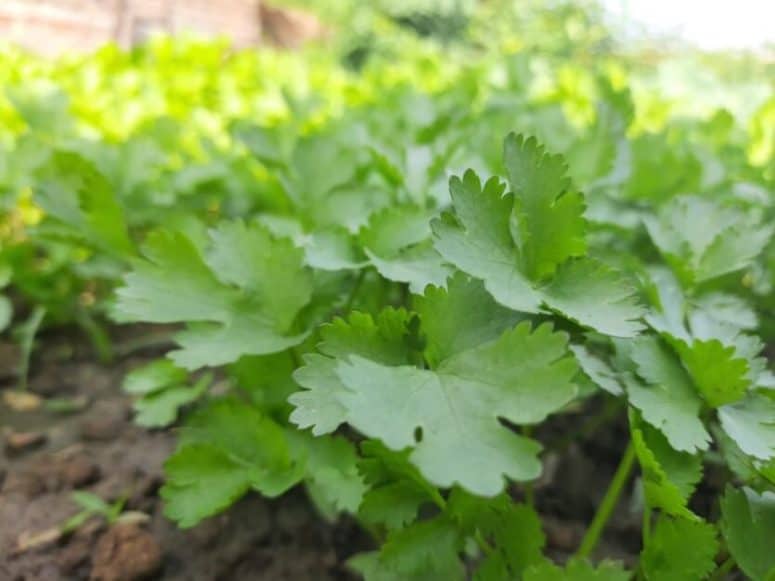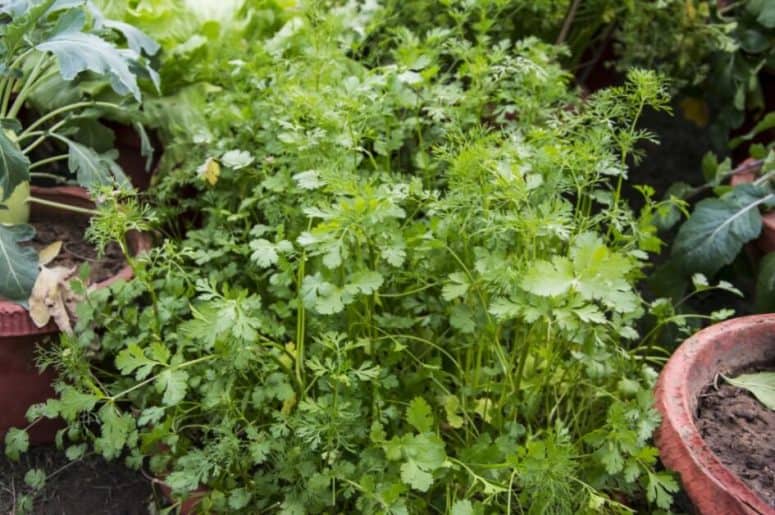How to Grow Cilantro At Home (A Beginner’s Guide)

Cilantro is one of the most famous herbs for Mexican and Asian cuisines. The pungent taste and warm sensation of eating it in your dish are exceptional!
You must have seen cilantro somewhere in the kitchen, haven’t you? In terms of appearance, its green and the sharp edge of the leaves are what you will notice.
So many people use it in their dish, but growing it? Not so many people do it because they think it is not easy. But in fact, cilantro is one of the easiest herbs to grow at home!
I know you’re here to learn more about growing cilantro at your home. So let’s dig in!
Cilantro Varieties
Before you start planting cilantro, it’s good to know its varieties for better knowledge and later use.
There are some different types of cilantro that people use in their traditional cuisines.
Calypso Cilantro
Calypso cilantro is the slowest cilantro to bolt. That is why it is the best cilantro to be planted in a hotter climate. Calypso tastes citrusy and savory. Serve them when fresh for the best flavorwise.
Leisure Cilantro
Usually, people in the international scoop refer leisure cilantro to coriander. Coriander is known as the dried seeds of cilantro.
Meanwhile, cilantro is the grown leaves and stems of the plant. Both work perfectly to spice up food.
This cilantro is also very aromatic and slowly bolt, which is also suitable for a hotter climate. The leaves of leisure cilantro are very fragrant, and that somehow invites some mutual insect to come.
Cruiser Cilantro
Again, people commonly refer to cruisers as coriander instead of cilantro. That is because this one relates to the seeds that could grow glossy and dark green cilantro.
This one also bolts very slow, which means it could keep the tasty and delicacy from the cilantro leaves and stems.
Santa Cilantro
Santa cilantro generally has similar characteristics as the others. What sets this one apart is that this one grows a little bushier than the others, making it seen grow faster.
Cilantro Cultivation
Now you know the varieties of cilantro. I guess it’s time for you to learn about cilantro’s cultivation, starting from the soil until the divisions. There you go!
Soil Requirements
You will grow the best cilantro in proper soil, which is in between 6.2 to 6.8 acid pH. Of course, you also need to be mindful of keeping the soil well-drained.
Keep the soil dry and never get it overmoist. Otherwise, you will have your cilantro blooms flower very fast, and the taste of the leaves and the stems are not going to be as intense.
Also, apply some compost and organic matter to your soil for better growth.
Sun Requirements
Herbs love sunlight! As for cilantro, this one likes a mix of full sun and partial shade.
Therefore, it’s best to grow your cilantro in a garden spot that is shady and not going to be too sunny. Otherwise, the sunlight could it the leaves and burn them.
Additionally, cilantro is going to bolt faster with too much direct sunlight exposure. Therefore, planting cilantro in the pot indoors is not a problem, as long as it gets enough sunlight and proper care.
Hardiness
As an annual herb, cilantro is tolerant of light frosts. However, cilantro is going to struggle in a very hot and humid temperature. It even bolts very quickly in hot weather, which makes the leaves taste bitter.
Therefore, cilantro’s hardiness depends on the climate where it is growing. You can plant cilantro in the spring if you grow it in cooler temperatures like zone 3 to 8.
Meanwhile, if you live in warmer climates like zone 9 to 11, you can plant cilantro in fall or winter.
Water
Be mindful to water the soil once it’s dried out. You have to keep the soil moist but not overly damp.
On the other hand, you must never let the soil soggy, for the excess water or moisture could be detrimental to your cilantro.
Fertilizer
Cultivating cilantro is very simple! You do not have to fertilize cilantro to grow it at home. You can save your cash and let the bush coming.
It won’t hurt to give the soil organic matter or any nutrient to help the soil thrive in the first period of cultivation.
Mulch
Do we need mulch for cilantro plants? Well, cilantro would love to keep the weeds down by adding mulch. Moreover, adding just about 5 inches of mulch can help you keep the moisture of the soil.
Pruning
Pruning is one of the ways to encourage more growth. To do it, pinch back the leaves for about an inch.
If you wish to extend the plants for more bushy growth, snip the soft stems regularly and rotate the plant as you harvest to encompass the whole plant.
Division
Yes, it is possible to root-divide cilantro. If you plant cilantro in a glass of water, you can grow the roots longer.
When the root has grown long enough, plant them in the pot or soil. You will have a full-plant after doing that step, also called the root division, by the next few weeks.
Best Methods to Grow Cilantro
The best and most recommended way to plant cilantro is by sowing it from seeds. It is very easy to germinate cilantro seeds, and cilantro is a fast-growing herb. Well, how to grow cilantro from seeds, then?
First up, prepare soil mixed with some compost and organic matter to a depth of at least 18 inches. Be mindful of raking the area smooth and starting sowing the seeds.
Sow the seeds to 1/4-inch deep in your garden or container (for indoors). Space the seeds from 6 to 8 inches apart in rows. The best time to sow cilantro seeds is in the late spring or early summer.
Grow the seeds by diligently keeping the soil moisture. You can give them water-soluble fertilizer once they reach about 2 inches. Trust me; they are going to multiply.
How to Care for Cilantro
Growing cilantro requires you to take care of the plant while growing it. You have to be ready for the propagation, storing them, and not to mention the pests and diseases that may appear.
Don’t worry. We provide the exact information you need.
Pests/Disease
The most common pest for cilantro is fungal wilt, leafhoppers, whiteflies, mildew, and aphids, including willow carrot, armyworm, cutworm, and root-know nematode.
That may sound quite much, but the troubleshooting is simple! Control that by having enough and proper watering t the soil, and use antibacterial soap, insecticide, or liquid to clean up debris or dead leaves.
As for diseases, cilantro could be affected by powdery mildew, damping-off, carrot motley dwarf, soft rot, and bacterial leaf spot.
However, those diseases won’t appear if you don’t overwater the plant or doing any treatment while the plant is still wet. Simple!
Propagating Cilantro
The process of propagating cilantro is easy. You can pinch back the 1/4 top stems of the plant to produce better growth next.
However, once cilantro grows bushy, it is going to self-sow and ready to produce more.
Therefore it is best to directly plant cilantro in the garden rather than transplanting it from the pot. Even better, you can harvest the seeds for the next season if you let the plant grow mature.
Harvesting Cilantro
After three to four weeks of sowing cilantro seed in the garden, you can start harvesting! How simple was that?
Harvest your cilantro when it has grown 4 to 4 inches tall by cutting the leaves at the bottom of the plant. Be mindful to avoid harvesting too much, such as more than one-third of the plant.
You will weaken the plants’ growth if you cut too much. Instead, cut as you need to encourage more growth.
If you are meant to harvest the cilantro seeds, which is coriander, you can clip the seed heads and put them upside down in a paper bag or some similar materials.
After that, give it time for a couple of days and dried it out.
Storing Cilantro
How would you store your delicate cilantro? Well, after harvesting the leaves or the seeds, it is time to store them.
For the seeds, you can keep them anywhere dry and fry or crush them to spice up your dish.
If you plan to save some seeds for another planting, crack the shell and soak the seeds in water. Leave it overnight and dry the seeds out before planting them next season.
As for the leaves, you want to keep them fresh. Before storing them, do damp wrapping with the towel around the cilantro and put them in the refrigerator. Fresh cilantro pops up the best flavor if you put them at the last minute of cooking.

